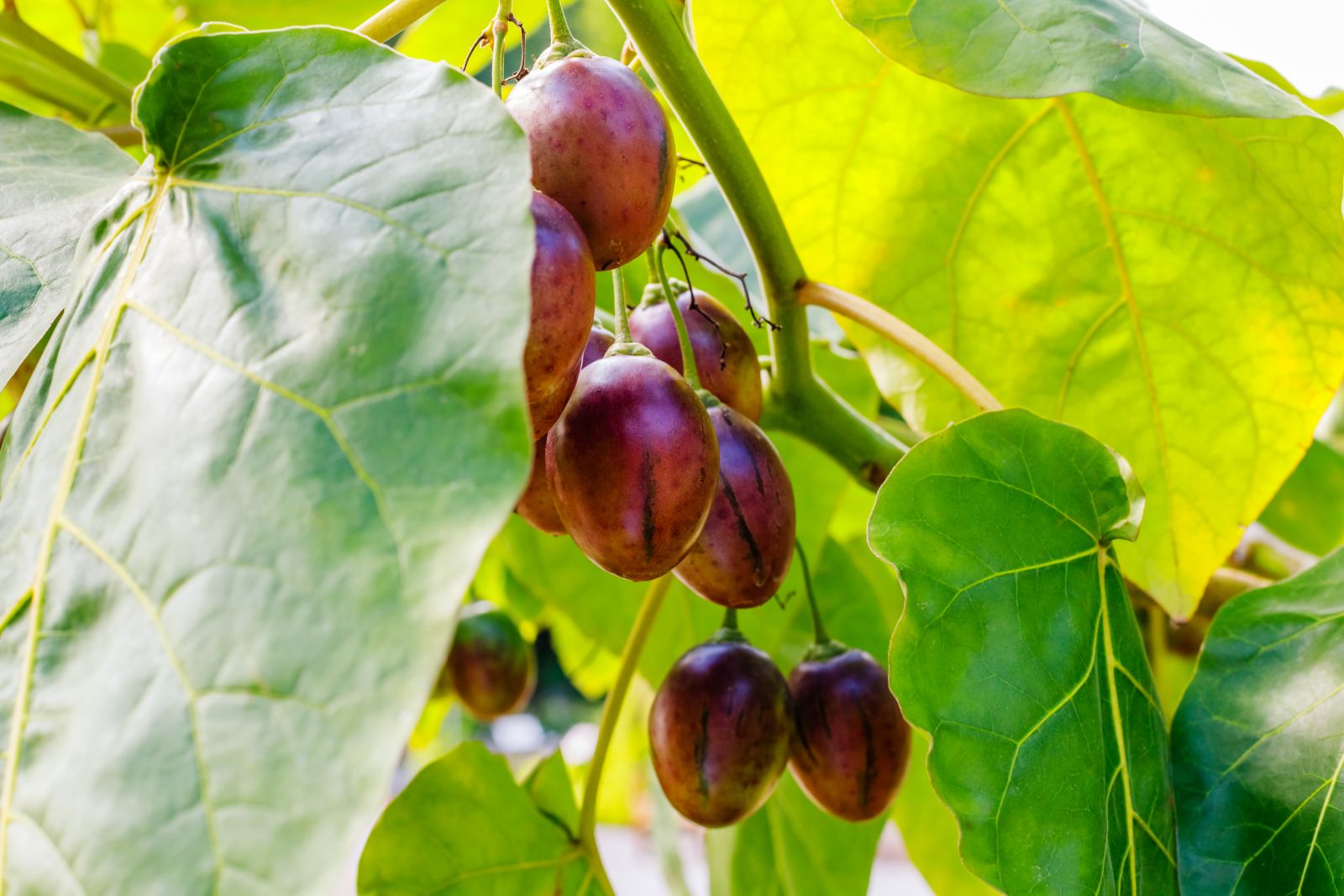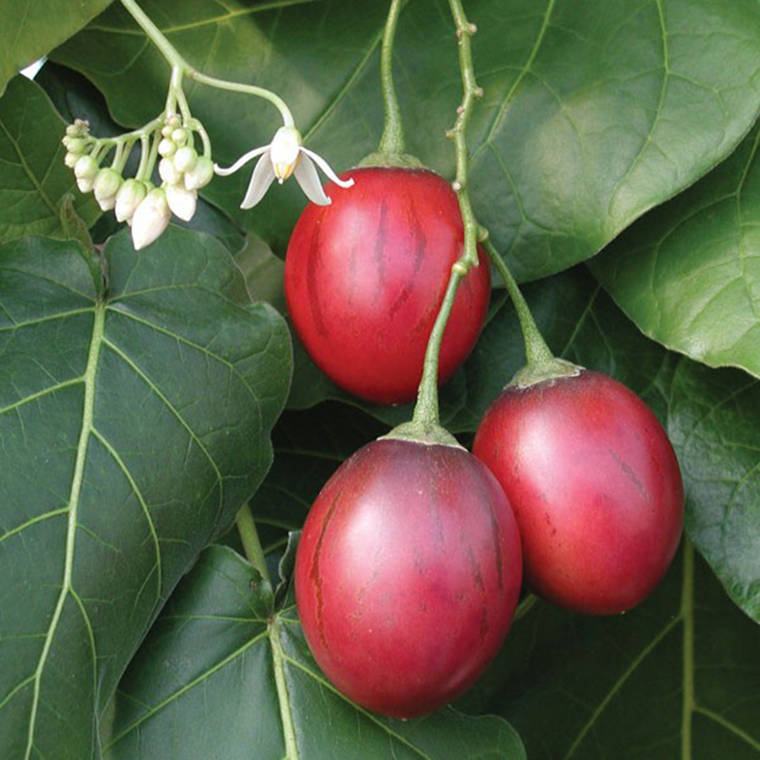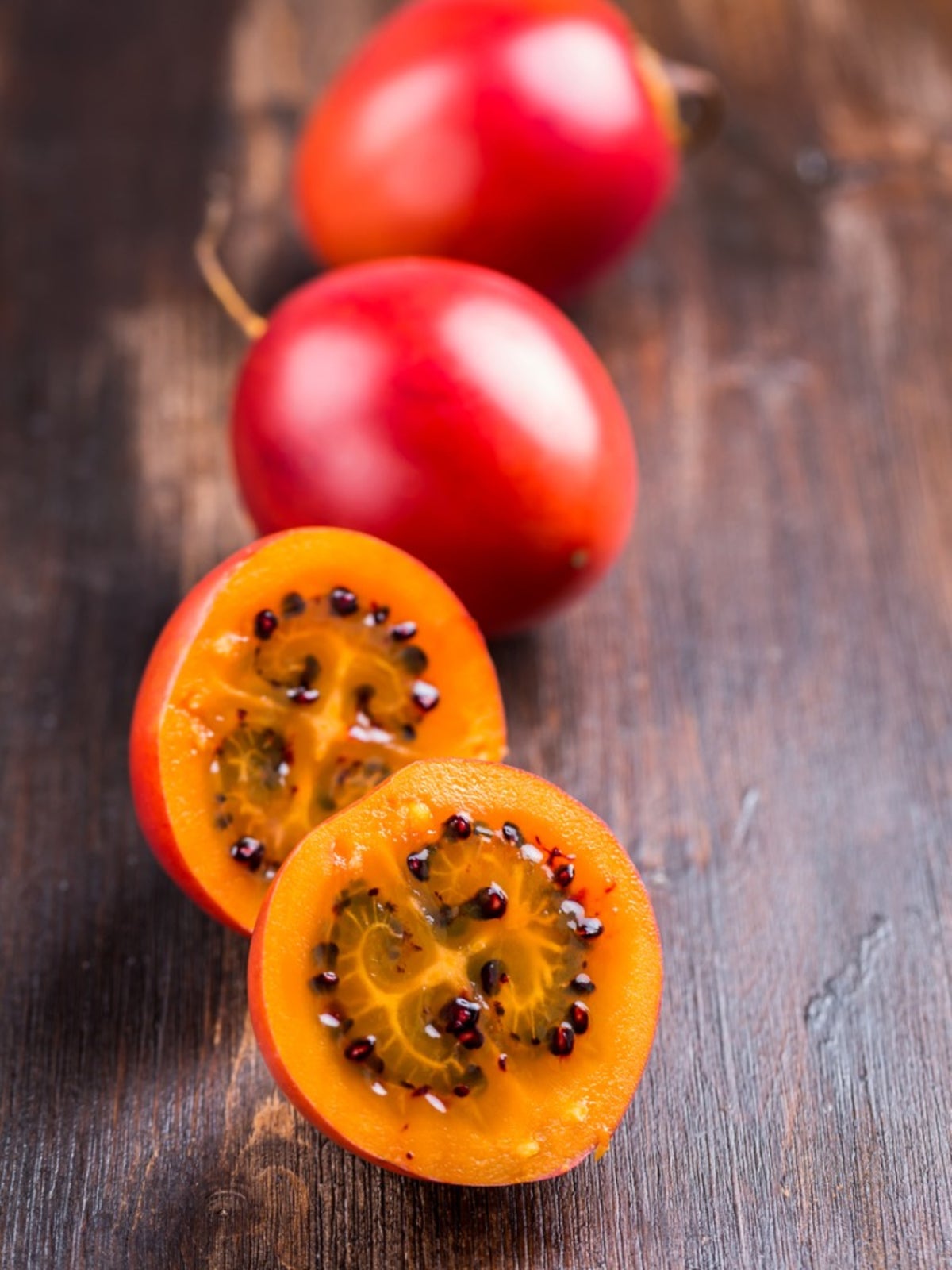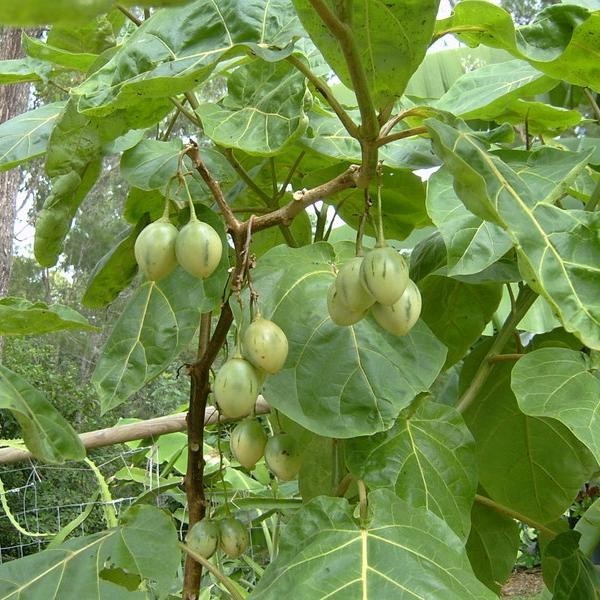
Tamarillo "Tree Tomato" Tomato, Vegetables, Botany
The tree is a fast growing, short-lived (about 3 years - but only in my experience), fragile, woody plant with extra large leaves, which can get to the size of a dinner plate. Wikipedia states the tamarillo tree can live to 12 years and reaches peak fruit production after 4 years. From what I have experienced, seen, and read, the tree is.

Roots 'n' Shoots Tamarillo (Tree Tomato) How to Grow Fruit of the Month
Propagation of the tree tomato Harvest tamarillo Uses and ingredients of tree tomatoes The fruits of the tamarillo ( Solanum betaceum ) look very similar to tomatoes, which is why the tamarillo is also known as the tree tomato. In fact, like the tomato ( Solanum Lycopersicum ), the tree belongs to the nightshade family (Solanaceae).

Tamarillo how to grow & care for the tree tomato Plantura
Tamarillo (Solanum betaceum), also known as tree tomato, tomate de arbol, and sachatomate, is a fruit-bearing plant native to South America but also cultivated in other parts of the world. The fruit is about the size of a large egg and has smooth, shiny skin that can be red, orange, or yellow.

Tamarillo Tree Tomato Buy Tamarillo An Evergreen Tree 24m High
Tamarido (Tree Tomato) The tamarillo or tree tomato (Cyphom-andra betacea) is native to the Andes, and has been cultivated on mountainsides since long before Europeans arrived. Today, it is grown in gardens from Chile to Venezuela, and its fruits are among the most popular of the region. On the Colombian and Ecuadorian uplands, for instance, it.

Plant of the Month Tamarillo Tree tomato attractive option for
A mature tree bears pink-white flowers that come in clusters of 10 to 50 floral pieces. They produce one to six fruits per cluster. The fruits are generally egg-shaped measuring 4 - 10 centimetres long. The plant has a lifespan of up to 12 years. Ecological requirements for tamarillo (tree tomato) Tamarillo is a subtropical plant.

How to grow tamarillo or tree tomato GardenDrum
Tamarillo, the tomato tree The tamarillo is a fruit shrub native to the tropics which bears surprising fruits with firm flesh and a tangy, pungent taste. Top Tamarillo facts Name - Solanum betacea (formerly Cyphomandra betacea) Family - Solanaceae or nightshade Type - fruit tree Height - 3 to 13 feet (1 to 4 m) (in its natural environment)

How to grow tamarillo or tree tomato GardenDrum
Tree tomato tamarillo ( Cyphomandra betacea) is a lesser-known plant in many regions but makes a very nice addition to the landscape. The South American native is a small-growing shrub or semi-woody tree reaching heights between 10 and 18 feet (3-5.5 m.). Tamarillo trees bloom in early spring, producing fragrant pink flowers.

Tamarillo Tree Tomato Cyphomandra betacea 10 Seeds Etsy
The tree tomato tamarillo is a fruit that is similar in appearance to a tomato. It is oval-shaped and comes in a variety of colors, including red, yellow, and purple. The fruit is typically eaten raw and has a tangy, slightly sweet flavor. Importance of Growing Tree Tomato Tamarillo.

Roots 'n' Shoots Tamarillo (Tree Tomato) How to Grow Fruit of the Month
A tomato tree (Tamarillo) is a perennial shrub, native to South America (subtropical). It is part of the nightshade family, Solanaceae (related to tomatoes & peppers). A tomato tree has odorous green leaves, fragrant pink or lavender flowers, and edible fruit that is yellow, orange, red, or purple.
Roots 'n' Shoots Tamarillo (Tree Tomato) How to Grow Fruit of the Month
Where to Plant Tree Tomato Tamarillo thrives in hot USDA Zones 10-11 climates. It is a hardy shrub or tree that can be planted directly in the ground or in a pot. Choose a location that receives around six to eight hours of direct sunlight. Tree tomato also benefit from partial shade, particularly in the afternoon, in the hottest regions.

PlantFiles Pictures Tree Tomato, Tamarillo (Cyphomandra betacea) by
Note: It's best to prune your tamarillo tomato tree during the winter months, while it's dormant. This will minimize stress on the plant and encourage healthy growth in the spring. Training Techniques. Training your tamarillo tomato tree's branches will help to support the weight of the developing fruits and prevent them from breaking off.

Tamarillo, The Tomato Tree How To Grow And Care
It does get the point across! Step 1 - Prepare the tamarillo by removing the skin and stem. Do a fairly small dice. Step 2 - Dice and mince all of the fresh ingredients. Add the citrus juice - Add the fresh-squeezed citrus juice to the prep bowl. Stir to combine. Season with sea salt and fresh ground pepper.

10 Fresh Seeds /w Instructions Tomate de árbol, Tamarillo, Tomarillo
Tamarillo, also known as the tree tomato, is a lesser-known fruit that boasts an impressive array of health benefits. Originating from the Andes Mountains of South America, this vibrant and tangy.

Tamarillo Tomato Tree Care Information On Growing Tree Tomatoes
A tamarillo is its own thing, even if the plant is sometimes called a tomato tree. Originally found in Latin and Central America, this fruit has become a popular ingredient in parts of India, Asia, Australia, and New Zealand, where it was dubbed "tamarillo."

Tree Tomato (Red Tamarillo) Organic Seeds
The tamarillo (Cyphomandra betacea) must surely be the most under-rated and under-planted fruit tree in my region… and yet it is unfussy, extremely fast-growing and bears delicious fruit (peel the rind after dunking in boiling water for 3 minutes, or halve fresh and scoop out the inside).The red cultivars are tart - ideal for preserves, pies, salads and desserts, whereas the orange ones.

Tomato Tree The "Tamarillo", Can Produce up to 3000 Pounds of Tomatoes
Tomatoes that grow on a tree? Let us introduce you to the tamarillo. Discover all you need to know about the tree tomato, including how to grow your own and care for it. It is no coincidence that the fruits of the tamarillo look very similar to tomatoes [Photo: nnattalli/ Shutterstock.com] Are tree tomatoes a type of tomato?